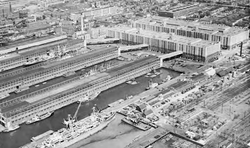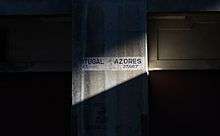Brooklyn Army Terminal
|
U.S. Army Military Ocean Terminal | |
|
Side view | |
 Brooklyn Army Terminal  Brooklyn Army Terminal  Brooklyn Army Terminal | |
| Location | 58th-65th St. and 2nd Ave., Brooklyn, New York |
|---|---|
| Coordinates | 40°38′40″N 74°1′30″W / 40.64444°N 74.02500°WCoordinates: 40°38′40″N 74°1′30″W / 40.64444°N 74.02500°W |
| Area | 97.2 acres (39.3 ha) |
| Built | 1918–19 |
| Architect | Cass Gilbert |
| Architectural style | Industrial, Other |
| NRHP Reference # | 83001702[1] |
| Added to NRHP | September 23, 1983 |
The Brooklyn Army Terminal is a large complex of warehouses, offices, piers, docks, cranes, rail sidings and cargo loading equipment on 95 acres (380,000 m2) between 58th and 63rd Street in Sunset Park, Brooklyn, New York City. It was the largest military supply base in the United States through World War II, and was later redeveloped for commercial use.
History
The complex was also known as the U.S. Army Military Ocean Terminal and the Brooklyn Army Base, as part of the New York Port of Embarkation. It was designed by Cass Gilbert and completed in September 1919. It was the largest military supply base in the United States through World War II. By the time the base was closed in the 1970s, over 3 million soldiers and 37 million tons of military supplies had passed through the terminal.[2] The 95 acre complex had its own railroad line, police and fire departments.[3] When built, it was the world's largest concrete building.[4]
The site was listed on the National Register of Historic Places in 1983. The listing includes 11 contributing buildings on an area of 97.2 acres (39.3 ha).[1][5] 58th Street separates the Army Terminal from the similar Bush Terminal.[6]
The federal government sold the property to New York City in 1981. The city government began a total renovation of the site in 1984, and then the New York City Economic Development Corporation started leasing the property as a center for dozens of light manufacturing, warehousing and back-office businesses.[2]
Ferry service

New York Water Taxi's Rockaway/Sandy Hook beach service formerly linked the 58th Street Pier at Brooklyn Army Terminal to Pier 11/Wall Street, the East 34th Street Ferry Landing, the Sandy Hook Bay Marina, and/or Riis Landing during the rush hour and on summer weekends. Ferry service at this location became very important during the aftermath of the September 11, 2001 terrorist attacks, and the 2005 New York City transit strike. This service was indefinitely suspended due to lack of funding on July 2, 2010.
In the aftermath of New York City Subway disruptions arising from Hurricane Sandy on October 29, 2012, Brooklyn Army Terminal eventually once again saw a resumption of city-subsidized ferry service to and from Manhattan. SeaStreak, a ferry company based in New Jersey with regular service from there into New York City, began running a Monday-through-Friday ferry service between a makeshift ferry slip at Beach 108th Street and Beach Channel Drive in Rockaway Park, Queens and Pier 11 and the East 34th Street ferry terminal, with five Rockaway-to-Manhattan runs in the morning and five Manhattan-to-Rockaway runs in the afternoon/evening, for a fare of $2, which was subsequently raised to $3.50.[7]

A stop at Brooklyn Army Terminal was added to each of those trips starting in August 2013, due to extensive Sandy-related damage to the nearby BMT Fourth Avenue Line (N R trains) infrastructure in the Montague Street Tunnel and the resulting disruptions to service between Brooklyn and Manhattan from the repair work.[8] The trip between Brooklyn Army Terminal and Manhattan takes approximately 15 minutes on the morning runs and 10 minutes on the afternoon/evening runs. Ample free commuter parking is available at the 58th Street Pier site. However, three return trips from Manhattan-to-Rockaway in the morning and from Rockaway-to-Manhattan in the afternoon/evening do not stop at Brooklyn Army Terminal. Ferry service between Brooklyn Army Terminal and Manhattan attracts an average of about 250 passengers per day, on top of the approximately 730 daily passengers riding the ferry between Rockaway and Manhattan.[9] Since its inception, the Rockaway-Brooklyn-Manhattan ferry service has carried nearly 200,000 passengers, according to city officials[10]
Originally intended as a stopgap alternative transportation measure only for the months until the IND Rockaway Line A train service was restored at the end of May in 2013, the ferry service proved to be popular with locals, and the city's contract with SeaStreak was extended several times, and the Brooklyn stop added. The subsidized service was scheduled to run through Jan. 31, 2014,[11] although community organizations, activists and elected officials in Rockaway and in Brooklyn campaigned for a permanent extension of the service.[12]
In late January, the city elected to extend the Rockaway-Brooklyn-Manhattan ferry service for another three months, until early May, and would at that time consider a further three-month extension, until Aug. 1, to give officials time to evaluate the ridership numbers and to determine whether to establish the service on a permanent basis. The fare was raised to $3.50 per ride during the extension period from $2 previously[10] Local officials and activists in Rockaway and in Brooklyn planned to intensify their efforts to boost ferry ridership during this interim period in hopes of gaining a favorable decision on the possibly permanent extension of the service. When the city government announced its budget in late June 2014 for the upcoming fiscal year beginning July 1, the ferry only received a $2 million further appropriation, enough to temporarily extend it again through October, but did not receive the approximately $8 million appropriation needed to keep the service running for the full fiscal year. Local officials and community activists expressed dismay with the decision, saying it was a blow to the Rockaways as the area continues to struggle economically in the aftermath of the 2012 hurricane. A spokesperson for the city government's Economic Development Corporation said that “We will continue to examine ridership and seek a sustainable funding stream that can support the $25-$30 subsidy per trip — the highest by far of any public transportation in the city.” [13] The ferry last ran on October 31, 2014.
The Brooklyn Army Terminal is expected to be served by the Citywide Ferry Service[14] starting in 2017.[15][16]
Notable tenants

Brooklyn Army Terminal is also home to a number of tenants specializing across a varied degree of industries. Some tenants include:
- New York City Police Department Intelligence Division[17]
- Jomashop.com, online watch and fashion retailer[18][19]
- Jacques Torres & Mr Chocolate, chocolatier[20][21]
- Uncommon Goods, internet retailer[22]
- New York City Bioscience Initiative center [23]
- Solomon R. Guggenheim Museum[24]
- American Museum of Natural History[24]
- chashama, artist studio program[25]
See also
- R. C. Williams Warehouse
- New York Cross Harbor Railroad
- Bush Terminal (Brooklyn industrial complex)
- Brooklyn Navy Yard
References
- 1 2 National Park Service (2009-03-13). "National Register Information System". National Register of Historic Places. National Park Service.
- 1 2 New York City Economic Development Corporation (2013). "Brooklyn Army Terminal: History"
- ↑ Kaysen, Ronda (2012-09-25). "Brooklyn's Industrial Space Retools for a New Era". New York Times.
- ↑ History of the Brooklyn Army Terminal Untapped Cities
- ↑ Raymond W. Smith (July 1983). "National Register of Historic Places Inventory-Nomination: U.S. Army Military Ocean Terminal / Brooklyn Army Terminal, Brooklyn Army Base, N.Y. Port of Embarkation". New York State Office of Parks, Recreation and Historic Preservation. and Accompanying 22 photos and Accompanying photo captions
- ↑ Myths of the Brooklyn Army Terminal Untapped Cities
- ↑ "Seastreak Ferry New Jersey, New York and New Bedford, Martha's Vineyard". Seastreakusa.com. Retrieved 2014-03-11.
- ↑ McFadden, Katie (2013-08-02). "Ferry Will Make Brooklyn Stop | www.rockawave.com | Wave of Long Island". www.rockawave.com. Retrieved 2014-03-11.
- ↑ "Ferry Facts | www.rockawave.com | Wave of Long Island". www.rockawave.com. Retrieved 2014-03-11.
- 1 2 "Rockaway Ferry Floats On Through May, But Trip Will Cost Nearly Double - Rockaway Beach - DNAinfo.com New York". Dnainfo.com. 2014-01-20. Retrieved 2014-03-11.
- ↑ Guarino, Dan. "Ferry Lives On | www.rockawave.com | Wave of Long Island". www.rockawave.com. Retrieved 2014-03-11.
- ↑ McFadden, Katie (2013-12-06). "A Ferry Strong Commitment | www.rockawave.com | Wave of Long Island". www.rockawave.com. Retrieved 2014-03-11.
- ↑ http://www.amny.com/transit/rockaway-ferry-service-only-funded-through-october-1.8582809
- ↑ DNAinfoNewYork. "Proposed Routes for NYC's Expanded Ferry Service". Scribd. Retrieved September 22, 2016.
- ↑ "Citywide Ferry Service to Launch in June 2017, Official Says". DNAinfo New York. 2016-03-03. Retrieved 2016-09-22.
- ↑ "New York City's Ferry Service Set to Launch in 2017". NBC New York. Retrieved 9 May 2016.
- ↑ Goldman, Adam (2011-08-31). "Inside the spy unit that NYPD says doesn't exist". AP. Retrieved 30 December 2013.
- ↑ "JomaShop.com moves headquarters from Manhattan to Brooklyn". Internet Retailer. Retrieved 30 December 2013.
- ↑ "Jomashop.com in Brooklyn, NY 11220". Chamber of Commerce. 2012-11-26. Retrieved 2014-03-11.
- ↑ Slide 9 Slide 9. "Featured Tenants". BKLYN Army Terminal. Retrieved 2014-03-11.
- ↑ (2013-01-30). "Chocolatier To Open Factory In Brooklyn Army Terminal - NY1". Brooklyn.ny1.com. Retrieved 2014-03-11.
- ↑ . "From Elvis Presley To Jacques Torres, Public Gets First Look At Brooklyn Army Terminal". NY1. Retrieved 2014-03-11.
- ↑ "Brooklyn Army Terminal". Nycbiotech.org. Retrieved 2014-03-11.
- 1 2 "Brooklyn Army Terminal opening up for tours of the 95-year-old Sunset Park military depot". NY Daily News. 2013-09-14. Retrieved 2014-03-11.
- ↑ Blau, Reuven (2014-09-03). "Brooklyn Army Terminal to showcase 93 artist studios during rare public viewing". NY Daily News. Retrieved 16 September 2014.
External links
| Wikimedia Commons has media related to Brooklyn Army Terminal. |
.jpg)



